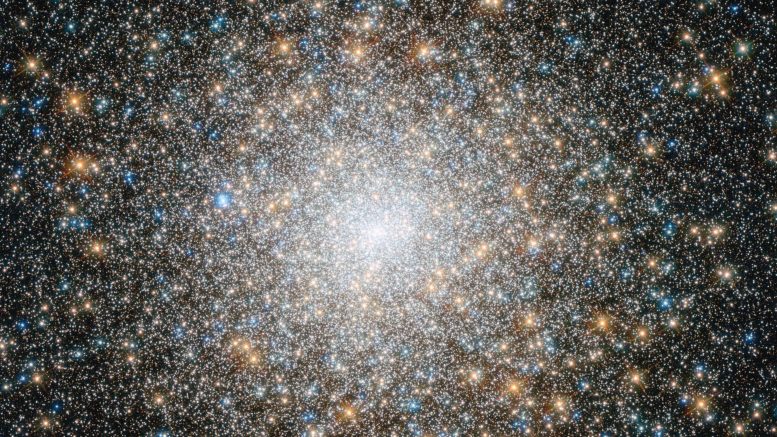Star clusters are very large groups of stars. There are two types of star clusters can be distinguished by astronomers. The first type of star cluster is the globular cluster, which are tight groups of hundreds to millions of old stars which are gravitationally bound. The second type of star cluster is the open cluster, which is a more loosely clustered groups of stars that are generally containing fewer than a few hundred members and are often very young in age. The reason for open clusters contain less than a few hundred members it that they become disrupted over time by the gravitational influence of giant molecular clouds as they move through the galaxy. That said, star clusters will move in the same direction, even after the clusters are no longer gravitationally bound.
Globular Cluster
Globular clusters are a type of star clusters that are arranged in roughly spherical groupings that range from a size of 10,000 to several million stars packed into regions in size of 10 to 30 light-years across. It is common for these globular clusters to be made up of very old stars, some of these stars have been said to be a few million years younger than the age of the universe itself. [1] Most of the stars are red and yellow due to how the stars have evolved; henceforth, a blue star in these clusters can be observed but are rather rare.
Globular clusters in the Milky Way Galaxy are distributed roughly spherically in the galactic halo. This means that around the center of the Milky Way, these globular clusters orbit in highly elliptical orbits. This distribution of globular clusters was used by astronomer Harlow Shapley in 1917 to make the first reliable estimate of the Sun’s distance from the galactic center.
The age of globular clusters were able to be determined as being a few million years younger than the universe using the Hipparcos satellite and accurate measurements of the Hubble constant. The brightest globular cluster in the northern hemisphere is Messier 13 in the constellation of Hercules.
Open Clusters
Unlike the spherically distributed globular clusters, open clusters are confined to the galactic plane, and are almost always found within spiral arms. They are generally young objects, up to a few tens of millions of years old, with a few rare exceptions as old as a few billion years.
The size of open clusters can be up to 30 light years across in size and contain usually up to a few hundred stars. This means that open clusters are much less densely populated when compared to globular clusters; however, these open clusters are much less tightly gravitationally bound. Therefore, these open are open clusters are able to be disrupted by the gravitational forces of other objects.
It is common for observations of open clusters to find a plethora of hot blue stars because the stars in these clusters typically tend to disperse before the stars die. The most prominent open clusters are the Pleiades and Hyades in Taurus.
Significance of Star Clusters
Star clusters are crucial to numerous areas of astronomy because all of the stars in these clusters are born at roughly the same time. This is important as the properties of these clusters differ as a function of mass; therefore, astronomers are able to utilize observations of both open and globular clusters to build stellar evolution theories.
Another use that astronomers have for studying clusters is to help determine the scale of distances in the universe. This is a result of several clusters being close enough to Earth to measure their distances using parallax. After performing these measurements of distance, scientists can plot a Hertzsprung–Russell diagram using the absolute values known on the luminosity axis. This diagram is then used to plot the values for a cluster which is an unknown distance away, so the position of the main sequence can be compared to that of the first cluster and the distance estimated. This process is known as main-sequence fitting, which has to have astronomers take into account reddening and stellar populations.
Scientists currently think that all the stars in the Milky Way were born in regions with embedded clusters that disintegrated, which means that star and planetary systems may have been affected by early clustered environments.
Resources
[1] = Robert Dinwiddie; Will Gater; Giles Sparrow; Carole Stott (2012). Nature Guide: Stars and Planets. DK. pp. 14, 134–137. ISBN 978-0-7566-9040-3.

Be the first to comment on "Star Clusters: An Introduction"